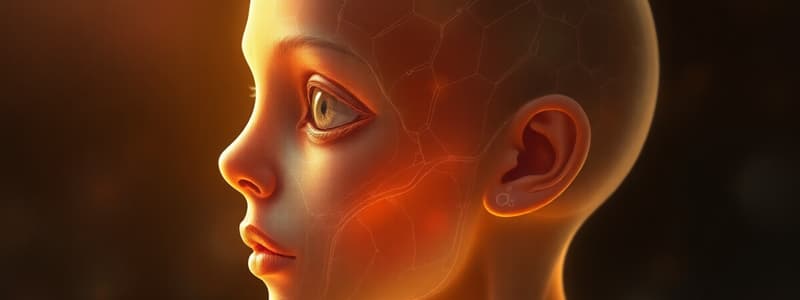Podcast
Questions and Answers
What structure forms first during early embryogenesis?
What structure forms first during early embryogenesis?
- Trilaminar embryonic disc
- Cranial arches
- Neural crest cells
- Blastocyst (correct)
Which of the following structures is primarily formed from the ectoderm?
Which of the following structures is primarily formed from the ectoderm?
- Connective tissues
- Neural crest cells (correct)
- Lining of the pharynx
- Muscles of mastication
During which weeks does the establishment of the trilaminar embryonic disc occur?
During which weeks does the establishment of the trilaminar embryonic disc occur?
- Weeks 3-4
- Weeks 2-3 (correct)
- Weeks 1-2
- Weeks 4-5
Which embryonic layer contributes to the formation of the tongue?
Which embryonic layer contributes to the formation of the tongue?
What are the five facial prominences that form the face?
What are the five facial prominences that form the face?
Which germ layer gives rise to cranial nerves?
Which germ layer gives rise to cranial nerves?
What forms the foundation for the head and neck structures?
What forms the foundation for the head and neck structures?
Which of the following structures does the endoderm primarily contribute to?
Which of the following structures does the endoderm primarily contribute to?
Which of the following structures fail to fuse properly during development, resulting in a cleft palate?
Which of the following structures fail to fuse properly during development, resulting in a cleft palate?
What is the primary consequence of tongue-tie (ankyloglossia) on an individual's oral function?
What is the primary consequence of tongue-tie (ankyloglossia) on an individual's oral function?
Which of these developmental anomalies is NOT directly related to the fusion of specific facial structures?
Which of these developmental anomalies is NOT directly related to the fusion of specific facial structures?
What is the main reason why early intervention is crucial in treating cleft lip and palate?
What is the main reason why early intervention is crucial in treating cleft lip and palate?
What factors can contribute to craniofacial malformations aside from genetic predisposition?
What factors can contribute to craniofacial malformations aside from genetic predisposition?
Flashcards
Cleft Lip
Cleft Lip
A birth defect where the upper lip is not completely closed, due to a failure of the medial nasal prominences and maxillary prominences to fuse.
Cleft Palate
Cleft Palate
A birth defect where the roof of the mouth (palate) is not completely closed, due to a failure of the palatine shelves to fuse with each other or the nasal septum.
Tongue-tie (Ankyloglossia)
Tongue-tie (Ankyloglossia)
A condition caused by the tongue being attached to the floor of the mouth by a short or thick frenulum, preventing normal tongue movement.
Developmental Anomalies
Developmental Anomalies
Signup and view all the flashcards
Environmental Influences on Fetal Development
Environmental Influences on Fetal Development
Signup and view all the flashcards
Early Embryogenesis (Weeks 1-4)
Early Embryogenesis (Weeks 1-4)
Signup and view all the flashcards
Blastocyst
Blastocyst
Signup and view all the flashcards
Bilaminar Embryonic Disc
Bilaminar Embryonic Disc
Signup and view all the flashcards
Trilaminar Embryonic Disc
Trilaminar Embryonic Disc
Signup and view all the flashcards
Neural Crest Cells
Neural Crest Cells
Signup and view all the flashcards
Pharyngeal Arches
Pharyngeal Arches
Signup and view all the flashcards
Facial Prominences
Facial Prominences
Signup and view all the flashcards
Palate
Palate
Signup and view all the flashcards
Study Notes
Embryology of the Head, Face, and Oral Cavity
-
Early Embryogenesis (Weeks 1-4):
- Development starts with fertilization, leading to cleavage and blastocyst formation.
- By week 2, a bilaminar embryonic disc (ectoderm and endoderm) forms.
- By week 3, a trilaminar disc (ectoderm, mesoderm, and endoderm) emerges, providing basic tissue for organs.
- Neural crest cells, originating from ectoderm, migrate and contribute to various structures.
-
Weeks 4-6:
- Neural crest cells form structures like cranial nerves and parts of the peripheral nervous system.
- Pharyngeal arches develop, foundational for the jaw, face, and oral cavity aspects.
-
Weeks 5-8:
- Five facial prominences (frontonasal, maxillary, and mandibular) form the face.
- Development of primary and secondary palates, along with the tongue, begins.
Embryonic Origins of Head, Face, and Oral Structures
-
Ectoderm:
- Forms the neural plate, evolving into the neural tube and neural crest cells crucial for craniofacial skeleton, teeth (dentin and cementum), and cranial nerves.
-
Mesoderm:
- Contributes to facial and neck musculature (e.g., mastication muscles).
- Forms parts of the skull and connective tissues.
-
Endoderm:
- Lines the pharynx and forms parts of neck glands (e.g., thyroid and parathyroid).
Consequences of Developmental Interruptions
-
Cleft Lip and Cleft Palate:
- Due to failure of fusion in facial prominences (medial nasal and maxillary).
- Leads to difficulty in feeding, speech, and hearing if not addressed early.
-
Tongue-tie (Ankyloglossia):
- Incomplete separation of tongue from the floor of the mouth during development.
- Impacts speech, feeding, and oral hygiene.
-
Other Anomalies:
- Genetic factors, infections, drugs, and nutritional deficiencies during pregnancy can cause a range of craniofacial malformations, affecting teeth, jaw alignment, and overall oral cavity development.
Studying That Suits You
Use AI to generate personalized quizzes and flashcards to suit your learning preferences.




